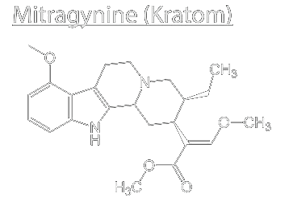
Mitragynine (Kratom)
Kratom, derived from the leaves of the Mitragyna speciosa tree, has gained popularity for its various strains and potential benefits. Commonly used for pain relief, boosting energy, and enhancing mood, its effects can vary significantly depending on the strain. However, users should be aware of potential side effects, which may include nausea, dizziness, and dependency with prolonged use. Moreover, safety warnings indicate that kratom can interact with other medications and may not be safe for everyone, particularly those with underlying health conditions or pregnant individuals. It is crucial for users to conduct thorough research and consult healthcare professionals before incorporating kratom into their regimen to understand both its benefits and risks.
Red Vein Kratom
What is It?
Red kratom, harvested from mature red-veined leaves, is the most popular among kratom users. The long drying process results in a dark color indicating a higher concentration of mitragynine and 7-hydroxymitragynine alkaloids, the active ingredients that interact with receptors in the body for the varied effects of kratom use.
Red kratom is versatile and, depending on the dosage and tolerance of the individual, helps manage issues such as low energy and pain. Red Maeng Da is the most potent kratom, with effects comparable to those of opioids. Red Borneo and Bali Red are other well-known red strains. Beginners should start with low doses to minimize the risk of adverse effects.
Red kratom is potent and fast-acting, making it popular for relief from migraines, arthritis, and other painful chronic conditions. People most often take red kratom as part of their night-time ritual due to its strong sedative effect.
Common Uses
Energizing
Management of opioid withdrawal
Pain relief
Sleep aid (sedation)
Stress relief and relaxation
Feelings of euphoria
Side Effects
Nausea
Headaches
Rashes and itching
Constipation
Loss of appetite/weight
Seizures
Nausea
Dehydration
Insomnia
Hot flashes
Since the red kratom experience is the most sought-after and most similar to opioid usage, the list of side effects is the most extensive. The potential for dependence and addiction to red kratom is high.
Green Vein Kratom
What is It?
Green vein kratom is harvested before the leaves are fully matured, and it undergoes minimal processing. The alkaloids in the plant have not yet fully developed, leading to a balanced alkaloid profile, providing a blend of energizing and relaxing effects.
Unlike red strains, which are best known for sedation, and white strains, which are associated with stimulation, green kratom is considered a more middle-of-the-road homeopathic supplement.
Traditional consumption involves preparing tea from powders of varieties such as Green Bali and Green Maeng Da.
Common Uses
Calming
Enhanced sense of well-being
Increased energy
Increased concentration and focus
Improved mood
Reduced anxiety
Side Effects
Insomnia
Jitters
Lightheadedness
Nausea
Nervousness
White Vein Kratom
What is It?
The kratom plant is a relative of the coffee family, and white vein kratom provides the uplifting, stimulating effects most often associated with drinking a cup of coffee. White kratom is differentiated from red and green kratom by its unique mix of natural compounds not found in mature leaves. Grinding of white kratom leaves begins after the leaves start to germinate.
The popularity of white vein kratom is a close second to red kratom. White kratom gives energy like caffeine, providing alertness and stamina, and is a popular morning or daytime energy boost and pick-me-up.
White kratom products include White Thai (from Thailand), White Maeng Da, and White Borneo. Maeng da is the best kratom for its superior quality and consistency.
Common Uses
Increased alertness
Increased energy
Increased outgoingness and sociability
Side Effects
Jitteriness
Insomnia
Rapid heartbeat
Which Type of Kratom is Most Addictive?
All of the different kratom strains have the potential for dependence and addiction when used regularly and in high doses. However, because of the popularity of the red strains and their similarities to opioids, dependence on red kratom is more likely. Many people use a combination of the strains for different effects, increasing the potential for reliance on the botanical.
Factors that can influence an individual’s dependence on kratom include dosage, frequency of use, form and strength of kratom, and the person’s health.
Withdrawal Treatment for Each Type of Kratom
Primarily, withdrawal treatment for kratom is the same regardless of the type of kratom used. However, the withdrawal process may be longer for individuals with a more severe dependence.
Kratom withdrawal symptoms can be mild (runny nose and restlessness) or more severe (aggression and abdominal cramps), mimicking an opioid withdrawal. For that reason, seeking guidance from a healthcare provider is advisable if you are considering discontinuing kratom. Medical professionals can help minimize the risk of relapse and ensure the safe management of withdrawal symptoms.
Kratom Safety Warning
Kratom is tempting to use to self-medicate for pain and anxiety, but no form of the botanical is approved for use by the U.S. Food and Drug Administration (FDA). The FDA warns Americans against using kratom for any purpose, and the U.S. Department of DEA has listed kratom as a Drug and Chemical of Concern.
Six states (Alabama, Arkansas, Indiana, Rhode Island, Vermont, and Wisconsin) and several cities (including San Diego and Denver) ban mitragynine and 7-hydroxymitragynine and have made it illegal to buy, possess, use, or sell kratom. Other states, cities, and counties are considering kratom regulations.
Only buy kratom from reputable vendors that follow safety standards to minimize the risk of unintended exposure to harmful substances. The American Kratom Association (AKA) maintains a list of GMP-qualified vendors that adhere to good manufacturing practices to ensure consistent quality and purity of products.
(Source: https://www.caron.org/addiction-101/drug-use/types-of-kratom)




Kratom undergoes metabolism in the body through a series of processes primarily carried out by the liver enzymes. How long does kratom linger in your system?
Unfortunately, there’s no simple, one-size-fits-all answer. Here’s how kratom is metabolized and the role of liver enzymes in breaking down kratom alkaloids:
Absorption and Distribution: After ingestion, kratom alkaloids are absorbed from the gastrointestinal tract into the bloodstream.
First-pass Metabolism: Once in the bloodstream, kratom alkaloids reach the liver, where they undergo first-pass metabolism. This process involves enzymatic action that breaks down the alkaloids into metabolites.
Liver Enzymes: Specifically, cytochrome P450 (CYP450) enzymes in the liver are responsible for metabolizing kratom alkaloids. These enzymes catalyze oxidation reactions that transform the alkaloids into various metabolites.
Formation of Metabolites: The metabolites formed through this process are more water-soluble than the original alkaloids, which facilitates their elimination from the body via urine or bile.
Variability: The metabolism of kratom can vary among individuals due to genetic factors influencing enzyme activity and overall liver function.
Understanding the metabolism of kratom is crucial for determining its duration of action and potential interactions with other substances. The liver’s role in breaking down kratom alkaloids underscores the importance of liver health in managing kratom use and its effects on the body.
Factors Influencing Kratom’s Duration in the System
Kratom, a Southeast Asian plant derived from the Mitragyna speciosa tree, has exploded in popularity in recent years. Touted for its potential pain-relieving and mood-boosting properties, kratom use has surged, particularly among those seeking natural alternatives to conventional medications.
But with this growing popularity comes a crucial question: how long does kratom actually stay in your system? This information is vital for several reasons.
Individual Metabolism Variations: Each person metabolizes substances differently based on genetic factors, age, and overall health. Variations in liver enzyme activity can affect how quickly kratom alkaloids are broken down and eliminated.
Dosage and Frequency of Kratom Use: Higher doses and frequent use of kratom can prolong its presence in the body. Regular users may accumulate kratom alkaloids, leading to extended detection times.
Interaction with Other Substances: Concurrent use of other substances, such as medications or alcohol, can impact kratom metabolism. Some substances may inhibit or enhance liver enzymes involved in kratom metabolism, altering its elimination rate.
Health Conditions Affecting Metabolism: Certain medical conditions, particularly liver and kidney diseases, can impair metabolic processes. Individuals with compromised liver function may metabolize kratom more slowly, prolonging its presence in the body.
Personal factors and concurrent substance use should be considered when evaluating kratom use and its potential impact on health.
Different Types of Drug Tests for Kratom
Kratom can be detected through various drug testing methods, each with its own advantages and limitations. Understanding how long kratom stays in your system hinges on its metabolic journey within the body.
Urine Tests: Urine tests are the most common method for detecting kratom use. They are non-invasive, easy to administer, and can detect kratom metabolites for up to several days after use, depending on frequency and dosage.
Blood Tests: Blood tests can also detect kratom, but they are less common due to their invasive nature. Kratom alkaloids can typically be detected in blood for up to 24 hours after ingestion.
Saliva Tests: Saliva tests are becoming more popular for detecting recent drug use, including kratom. They are non-invasive and can detect kratom within a few hours to a couple of days after use.
Hair Tests: Hair tests are less commonly used for detecting kratom but can provide a longer detection window. Kratom metabolites can be detected in hair for up to several months after use, depending on the length of the hair sample.
Which Tests Detect Kratom Use?
But with this growing popularity comes a crucial question: how long does kratom actually stay in your system? This information is vital for several reasons. Understanding kratom’s detection window is important for individuals who may undergo workplace drug testing, athletes competing in competitions with banned substances, or those seeking medical procedures where knowing potential drug interactions is crucial.
Among the tests mentioned:
Urine tests are most commonly used and effective for detecting kratom use.
Saliva tests can detect recent kratom use.
Blood tests provide a short detection window.
Hair tests offer a long-term detection period but are less commonly used for kratom detection.
Choosing the appropriate test depends on factors such as the timeframe since the last use and the specific requirements of the testing situation. Understanding these testing methods helps in interpreting results accurately and comprehensively assessing kratom use.
Detection Windows for Kratom in Various Tests
The detection of kratom in drug tests varies depending on the type of test and several influencing factors:
Urine Tests
Detection Window: Kratom can typically be detected in urine for up to 7 days after use.
Factors Influencing Detection: Factors such as dosage, frequency of use, individual metabolism, and hydration levels can affect detection times. Higher doses and frequent use may prolong detection.
Blood Tests
Detection Window: Kratom alkaloids can be detected in blood for up to 24 hours after ingestion.
Factors Influencing Detection: Similar to urine tests, factors like dosage, frequency of use, and individual metabolism impact detection times. Blood tests are sensitive to recent kratom use.
Saliva Tests
Detection Window: Saliva tests can detect kratom within a few hours to 1-2 days after use.
Factors Influencing Detection: Recent use and dosage influence detection times. Saliva tests are effective for detecting recent kratom ingestion.
Hair Tests
Detection Window: Kratom metabolites can be detected in hair for up to several months after use.
Factors Influencing Detection: The length of the hair sample and the growth rate of the hair affect the detection window. Hair tests provide a long-term history of kratom use.
Understanding these detection windows and influencing factors is crucial for interpreting drug test results accurately. Factors such as dosage, frequency of use, individual metabolism, and the type of test used all play a significant role in determining how long kratom can be detected in various testing methods.
Conclusion
In conclusion, understanding how long kratom stays in your system is essential for navigating various situations, from workplace drug tests to medical procedures. Kratom’s metabolism primarily occurs through liver enzymes, influencing its detection window in different drug tests such as urine, blood, saliva, and hair tests. Factors like individual metabolism, dosage, frequency of use, and health conditions can significantly impact detection times.
For those seeking to speed up kratom elimination from their system, natural methods like staying active, maintaining a balanced diet, staying hydrated, and ensuring adequate sleep can support overall metabolic health. However, it’s crucial to approach these methods cautiously, as rapid attempts to accelerate elimination can pose health risks.
(Source: https://calusarecovery.com/blog/how-long-does-kratom-stay-in-your-system/)


